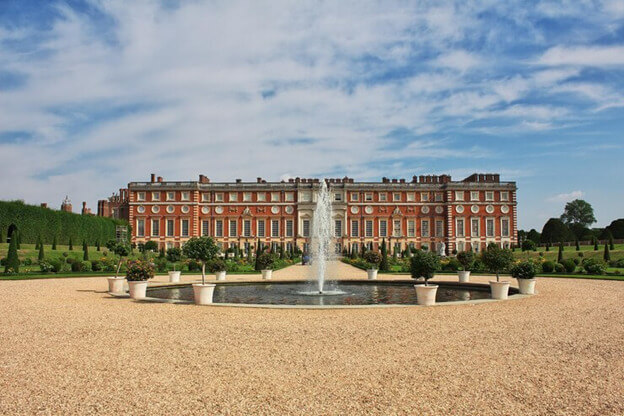About Hampton Court Palace
Hampton Court is a royal palace in the historic county of Surrey, located in the London Borough of Richmond upon Thames. It is 11.7 miles (18.8 kilometers) southwest of Charing Cross and is one of England’s most important surviving Tudor buildings. In the early 16th century, Cardinal Thomas Wolsey, a favorite of King Henry VIII, built Hampton Court Palace. Henry VIII significantly expanded the palace, making it one of England’s most opulent royal residences. The castle is famous for its art collections and beautiful gardens. It is a well-known tourist attraction that is open to the public.

(Image Source: Freepik)
History of Hampton Court Palace
Hampton Court Palace is one of England’s grandest structures and a must-see for any visitor to London. Cardinal Wolsey built it in 1515 on the banks of the River Thames. Following his demise, King Henry VIII took over the palace and transformed it into one of the most impressive palaces of the time.
Henry added a magnificent Tudor Great Hall, a chapel, and a tennis court to the palace. He also constructed a large Tudor kitchen and kitchens outfitted with cutting-edge cooking technology at the time.
The palace was renovated and expanded in a baroque style during King Charles I’s reign. After his defeat in the English Civil War, the castle was given to the Duke of Ormonde and reverted to being a royal palace.
The palace was renovated and modernized in the nineteenth century. It was opened to the public by Queen Victoria and remained so to this day.
Hampton Court Palace is now a popular tourist destination and a World Heritage Site. It is open to the public, and visitors can explore the grand rooms and gardens and view various historical artifacts.
The Chapel
The chapel at Hampton Court Palace is the Chapel Royal. It is a chapel still in use today and is the chapel of the British monarchs. The chapel was constructed in the 16th century and is an integral part of the palace. There are also two other chapels at Hampton Court Palace; the Chapel of St Mary and St George and the Chapel of St. Thomas a Becket. These chapels were built in the 17th century and used for private worship.
Grounds
Hampton Court Palace’s grounds are part of the palace’s historic estate and are in the London Borough of Richmond upon Thames, England. Gardens, parkland, riverside walks, and a maze are all part of the grounds. The grounds, gardens, and the palace are open to the public.
Hampton Court Palace’s gardens are world-renowned and the work of some of the most excellent landscape designers, including Sir Christopher Wren, Lancelot ‘Capability’ Brown, and William Kent. The Great Vine, the Privy Garden, the East Front Garden, the Wilderness, the Fountain Garden, the West Front Garden, the Maze, and the Home Park are among the gardens, as are some smaller areas.
The Great Vine is the world’s oldest grapevine, dating back over 200 years. It continues to produce grapes. The Privy Garden is a formal garden with topiary, hedges, and fountains that is popular for wedding photos. The East Front Garden is a traditional flower garden with a large sunken parterre and an ornamental lake. The Wilderness is a large parkland area with winding paths and a lake. The Fountain Garden is a formal garden with a large fountain and a pool in the center. The formal West Front Garden features a large terrace and an ornamental lake. The Maze is a giant hedge maze of over 1,400 yew trees. The Home Park encompasses a large area.
Some of the palace’s historic buildings and monuments, such as the Hercules Fountain, the Hampton Court Chapel, and the King’s Apartments, are also on the grounds.
The grounds are open all year, but the gardens are only available from March to October. The gardens are open for guided tours and host various events throughout the year.
Conclusion
Hampton Court Palace is one of the world’s most famous royal residences and a stunning example of Tudor architecture. It gives visitors a glimpse into the Tudor court and its inhabitants’ lives. Hampton Court Palace, with its magnificent Tudor Great Hall and extensive gardens, is an incredible place to visit and learn more about the history of the British monarchy.
Recommended Articles
We hope that this EDUCBA information on “Advertising Budget” was beneficial to you. You can view EDUCBA’s recommended articles for more information,
